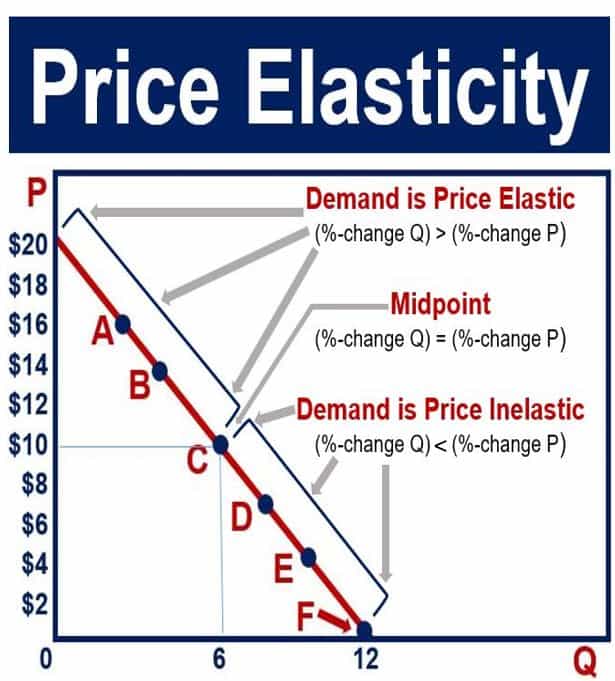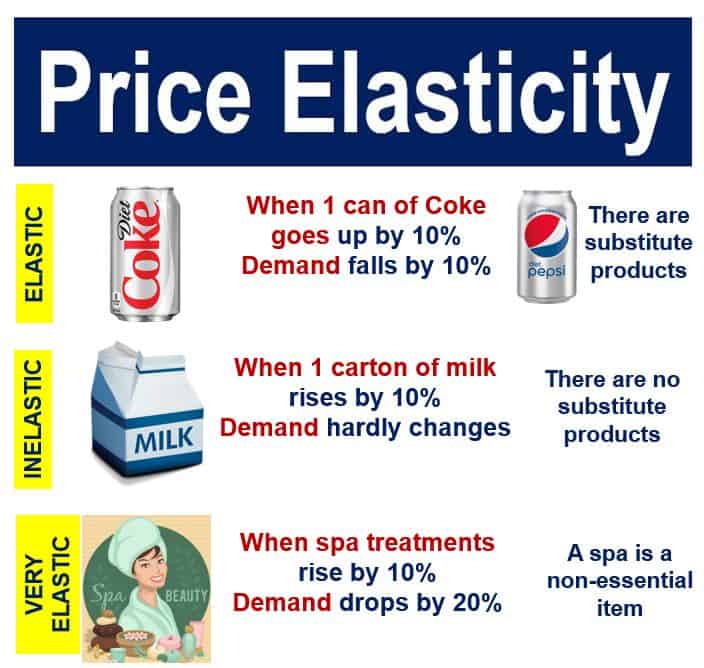Price Elasticity is a measure of how consumers react to the prices of products and services. Normally demand declines when prices rise, but depending on the product/service and the market, how consumers react to a price change can vary.
There are two types of price elasticities:
- Price elasticity of demand: also known as PED or Ed, is a measure in economics to show how demand responds to a change in the price of a product or service.
- Price elasticity of supply: also called PES or Es, is a measure that shows how the quantity of supply is affected by a change in the price of a good or service.
Moreover, consumer preferences and seasonal trends can significantly influence demand, adding complexity to how price changes affect market behavior.

The OECD (Organisation for Economic Co-operation and Development) offers the following definition:
“The price elasticity in demand is defined as the percentage change in quantity demanded divided by the percentage change in price.”
“Since the demand curve is normally downward sloping, the price elasticity of demand is usually a negative number. However, the negative sign is often omitted.”
Do not confuse the term with income elasticity of demand. Income elasticity of demand measures how demand for a product or service changes when people’s incomes change.
Price elastic vs inelastic
When demand or supply for something changes considerably after a price change, the product or service is very price elastic.
If, however, there is no change in demand or supply, or very little change, it is price inelastic.
This article focuses more on the price elasticity of demand. When there is good price elasticity, it means that the change in demand is greater than the change in price.

Example
Let’s suppose that the price of a Coke rises by 10%, and demand subsequently falls by 10%. Demand for Coke is price elastic.
Most goods have high price elasticity, unlike basic staple foods. If the price of bread rises 10% in London, demand for bread does not fall by anywhere near that amount; if at all. Bread is price-inelastic.
Price elasticity of staple goods in high-poverty areas, however, are different. In high-poverty areas, they follow the demand-price relationship of Giffen goods.
No substitute products
Several factors determine price elasticity. For example, if there are no substitute products, demand tends to be inelastic. In such cases, suppliers have some power over price.
Many substitute products
When there are many substitute products in existence, however, demand is usually elastic. Then suppliers have virtually no control over price.
Price elasticity is mostly inverse
Price elasticities nearly always have an inverse relationship, i.e., when the price goes up demand declines.
Only products and services that do not conform to the law of demand have a positive PED. Giffen or Veblen goods are excellent examples.
Veblen Goods
Veblen goods are luxury goods; demand for them rises when prices go up. Consumers buy Veblen goods to impress their neighbors, family, and friends.
They are status symbol-enhancing goods. Swiss watches, sports cars, jewelry, and designer handbags, for example, are Veblen goods.
Giffen Goods
These goods also defy the economic laws of price and demand, but for a completely different reason. Giffen goods are very basic products which low-income households rely on.
Examples of Giffen goods are rice in China, bread in Europe and North America, and tortillas in Mexico.
If the price of tortillas rises in Mexico, poor people will cut back on more expensive foods. They will reduce their meat consumption and consume more tortillas. Demand for Giffen goods rises when prices go up.
The price elasticity for most goods and services is inverse, i.e., demand falls when prices rise. However, it is positive for Giffen and Veblen goods, i.e., demand rises when prices go up.
Conversely, for luxury services such as first-class air travel or five-star hotel accommodations, price elasticity can also be affected by perceived value, where higher prices may signal superior quality and exclusivity to consumers.
Furthermore, increased access to market information and price comparison tools has heightened consumers’ sensitivity to price changes, thereby potentially increasing the price elasticity of demand for a wide range of products.

Calculating price elasticity
Calculating the price elasticity of a good or service is straightforward. We take the percentage change in demand and divide it by the percentage change of price.
Let’s say the price of a smartphone brand rises by 10%, resulting in a 10% decline in demand. We do the following calculation:
-10% (demand change) ÷ 10% (price change) = -1
The PED is -1 (minus one)
Price elasticity may vary from minus one to plus one. Most products and services range from minus one to zero. Giffen or Veblen goods, on the other hand, range from zero to plus one.
Alfred Marshall
Economic historians say that Alfred Marshall (1842-1924), a British economist, coined the term ‘elasticity of demand’ in his 1890 book – Principles of Economics.
Marshall Wrote:
“And we may say generally:— the elasticity (or responsiveness) of demand in a market is great or small according as the amount demanded increases much or little for a given fall in price, and diminishes much or little for a given rise in price … the only universal law as to a person’s desire for a commodity is that it diminishes… but this diminution may be slow or rapid.”
“If it is slow… a small fall in price will cause a comparatively large increase in his purchases. But if it is rapid, a small fall in price will cause only a very small increase in his purchases. In the former case… the elasticity of his wants, we may say, is great. In the latter case… the elasticity of his demand is small.”
